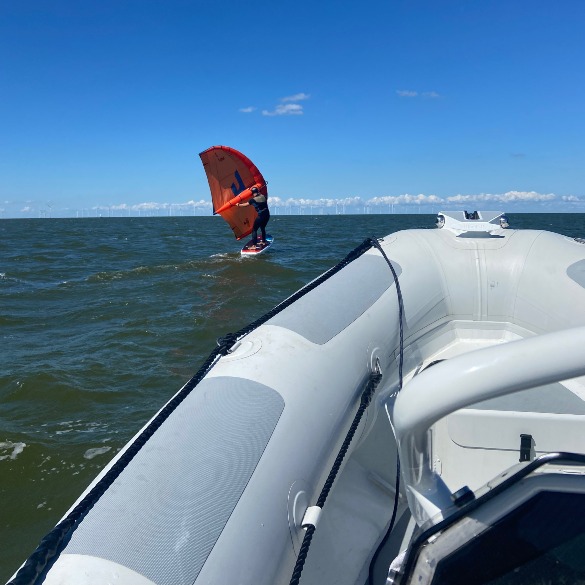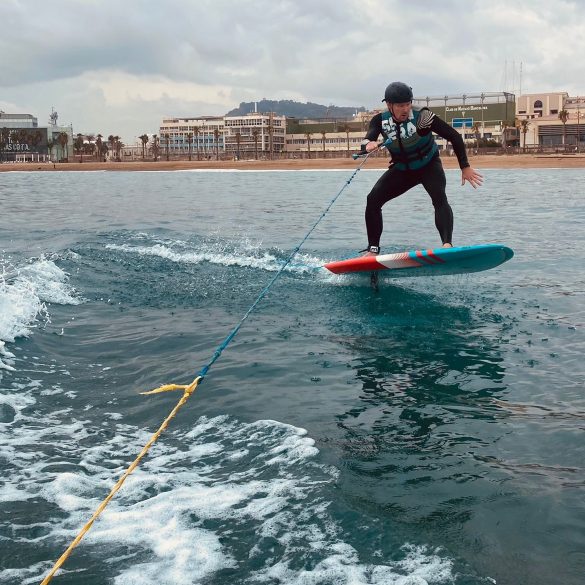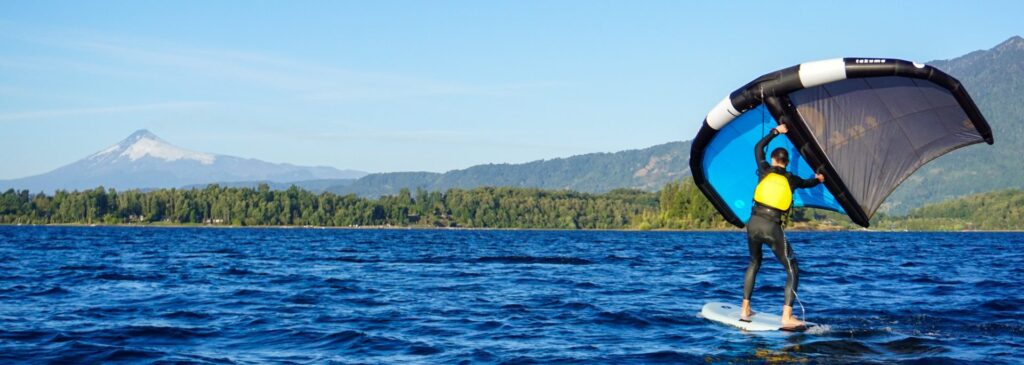How to learn wingfoil and what to keep in mind if you decide to learn how to wingfoil. Wingfoiling, the thrilling fusion of windsurfing, kitesurfing, and foiling, has captured the hearts of water sports enthusiasts worldwide. To provide aspiring wingfoilers with the best learning experience, instructors and schools employ diverse strategies tailored to individual needs. On this page, we explore different approaches used in wingfoil lessons to nurture skills, confidence, and a lifelong passion for wingfoiling.
One of the most effective strategies for wingfoiling learning is personalised instruction. Experienced instructors assess each student’s skill level, strengths, and areas for improvement. By tailoring lessons to individual needs, students receive focused guidance on essential techniques, such as wing control, foiling manoeuvres, and balance. This personalised approach accelerates the learning curve and ensures that each student can progress at their own pace, fostering a deeper connection with the sport.

Wingfoil lessons and a guidance boat
The instructor follows you with a (small) boat, allowing you to just focus on the learning process. Once you go too much downwind, a quick boat ride brings you back upwind.
Starting with a boat towing you
One strategy a school can have is to tow you with a boat, teaching you how to get on the foil first. This may work but it’s also risky.


Starting the other way around
A safer way of starting your wingfoil lessons is to start the other way around: first you manage the wing, then you get on a big size surf board (maybe even a SUP board) and you learn how to sail. After that, you get on the foil bit by bit. Ask your school about their vision and reasons.
Why should you take wingfoil lessons?
Wingfoiling is a sport with a learning curve. Mostly the first part of that learning curve can be a bit demotivating. It seems like all the other riders have to do zero effort to be flying around and you may feel like you’re the only one out there that has no clue. Don’t worry: we have all been there, that’s the good news. Even if you come from windsurfing there are things to learn.
Here are 5 reasons to consider taking wingfoil lessons.
- Safe and efficient learning:
Professional wingfoil lessons provide a safe and efficient learning environment. Experienced instructors guide beginners through the fundamentals of wingfoiling, teaching essential techniques such as how to handle the wing and how to get into the water safely. With proper instruction, students can avoid common beginner mistakes and progress quickly, ensuring a solid foundation for their wingfoiling journey. - Personalized guidance:
Wingfoil lessons offer personalized guidance tailored to each student’s skill level and learning style. Instructors assess individual strengths and areas for improvement, providing targeted feedback and adjustments to enhance performance. This personalized approach accelerates skill development, allowing students to maximize their potential in a supportive setting. - Access to quality equipment:
Wingfoil lessons typically include access to quality wingfoil equipment. Instructors ensure students are equipped with suitable boards, wings, and foils optimized for their size and skill level and different brands. Trying out different equipment during lessons helps students understand their preferences and assists in making informed gear choices in the future. - Focus on safety:
Safety is paramount in wingfoiling, and lessons emphasise safety practices and techniques. Instructors educate students on weather conditions, water hazards, and how to handle emergency situations. This knowledge not only instills confidence but also ensures a responsible and secure wingfoiling experience. See the wingfoil safety guide. - Accelerated progression:
With expert guidance and structured lesson plans, students experience accelerated progression in wingfoiling. Instructors break down complex manoeuvres into manageable steps, allowing students to grasp concepts and techniques more effectively. As a result, students gain confidence, become proficient riders, and can venture into more challenging wingfoiling aspects with ease.
Taking wingfoil lessons is a valuable investment in your wingfoiling journey. Whether you’re a beginner eager to learn the ropes or an experienced rider looking to refine your skills, professional lessons offer invaluable insights, safety assurance, and the chance to embrace the exhilarating world of wingfoiling with proficiency and passion.
Do you come from windsurfing?
There are many differences between windsurfing and wingfoiling, so you may have a couple of things to re-learn and de-learn before you will have success. See what to expect when switching from windsurf to wingfoil.

Deciding between private or group classes
For personal wingfoil lessons, there are basically to option: you go in a group or you get private lessons.
The personal (or private) wingfoil lessons may be more expensive compared to group lessons, where you share the cost and the time (and sometimes the equipment) with other participants. However, you get 100% focus of the instructor and that may pay off very well. Given the fact that wingfoiling is a sport that depends on the elements (mainly the wind and the waves), it’s wise to use your time on the water as efficient as possible. You don’t want to be waiting for the other student to finish to get your turn, and see that the wind has stopped meanwhile. That makes private lessons a good option. A school like Soal Surf in the Netherlands is a great place to learn this way.
Here are some pro’s and cons for private lessons and group lessons.
Group sessions
- Lower price
- You learn from mistakes and progress of others
- More fun if you go with friends (or make friends)
- The instructor is paying attention to all students
- Time (and sometimes equipment) are shared with other students
- You can recover while others are learning
- Your progress may be slowed down by other students
Private sessions
- More expensive
- You learn from your own mistakes and progress
- More efficient, especially if you have less time available
- You have the full attention of the instructor
- You have all of it to yourself for the whole duration of the lesson
- You probably get tired faster
- Your class is tailor made to your level

What to consider asking before getting wingfoil lessons
There are more and more places out there where you can learn wingfoiling. That’s the good news. However, every school has their own vision on what to learn first and in what order to learn the different steps of wingfoiling.
- What vision of learning how to wingfoil do you have?
Some schools prefer to teach you how to foil before they teach you how to handle the wing. This may mean that their intention is to tow you behind a motor boat by a rope, and teach you how to get on the foil first. In our experience, the better and safer way to learn how to wingfoil is to do the opposite: first you learn to manage the wing, then you try it on the water with a big (SUP) board, then you learn how to get on the foil. Consider these options and ask what motivation they have for their vision. - Do you have a boat so you can join me on the water?
If your wingfoil school has a motor boat to join you on the water, you may safe a lot of time and energy. Typically when you start, you will drift downwind and you need to recover your position. If the wingfoiling lessons are done from a boat, the instructor can pick you up from downwind and give you a quick ride back upwind. That way you can just focus on learning and growing. - Do you have helmets with audio?
Some wingfoil lessons are carried out by wingfoil schools that have helmets which are fitted with audio equipment. This allows you to speak with your instructor and receive straight feedback without having to scream across the water. - What happens if there is no wind during my class?
It can happen that you go out there and the wind drops during, or just before your class. Consider asking your school what happens in those cases: do they give you the option to reschedule, is that free of charge or not, can they give you a heads up a couple of hours before your class about the prediction… how does it work? Just so you know and consider your options. - How many lessons will I need?
Obviously the amount of lessons you need depends on you, on the conditions and on some other factors. But it is a good thing to ask. If the school says you will need at least 20 lessons, consider looking for another one. - Do you have a medical and accident insurance?
Wingfoiling is a risky sport so check if the wingfoiling school has the right insurances. You may also want to check with your own insurance whether you are covered in case of an injury.
See also:
